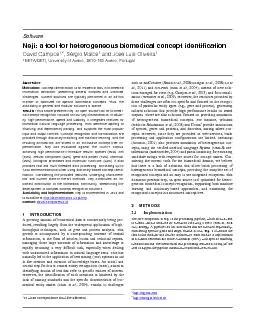

Smith et al 2008 Morgan et al 2008 Lu et al 2011 and JNLPBA Kim et al 2004 dozens of new solutions emerged for NER eg Campos et al 2013 and for normalization Wermter et al 20 ID: 824442
Download Pdf The PPT/PDF document "provided through dictionary matching and..." is the property of its rightful owner. Permission is granted to download and print the materials on this web site for personal, non-commercial use only, and to display it on your personal computer provided you do not modify the materials and that you retain all copyright notices contained in the materials. By downloading content from our website, you accept the terms of this agreement.
provided through dictionary matching and
provided through dictionary matching and machine learning, and the resulting annotations are stored in an innovative concept tree im-plementation. Neji was evaluated against (Smith et al., 2008; Morgan et al., 2008; Lu et al., 2011) and JNLPBA (Kim et al., 2004), dozens of new solu-tions emerged for NER (e.g. Campos et al., 2013) and for normali-zation (Wermter et al., 2009). However, the resources provided by those challenges are often too specificoptimized for hetercharacteristics in the best and most automated way as possible. In Neji, this is achieved through acomprehensive set of fea-tures, serving as a good starting point to develop NER solutions for the biomedical domain. To complement Gimli, establishing a relation between the entity mentionsand unique database identifiers, we developed a simple and general normalization algorithmbased on prioritized dictionaries.
Following this algorithm, if an identif
Following this algorithm, if an identifier is found in the first dictionary, the match is complete and the algorithm finishes. If no match is found in the first dictionary, the second one is used to find a match, and so its identifier is associated with the annotation. 2.1.6 and editing the generated annotations. Finally, JSON provides all the information contained in the tree, together with the sentence and respective character positions. 2.1.8 Parallel processing On top of the previously described features, Neji also supports multi-threading processing, automat-ically duplicating the required resources when necessary. This allows annotating multiple documents at the same time, significantly dropping processing times. 2.2 UsageWildcard input filter to properly indicate the files to process; and 6) Sup-port for compressed and uncompressed files. Such features allow anno
tat-ing a corpus using a simple bash com
tat-ing a corpus using a simple bash command, such as: !"#$%&!'()*&)&#+,-")&.)/01)*2)2,-+,-")u-rus. Finally, cellular components, The ccan see that Neji is the solution that presents overall best recall results without loss in precision. Neji obtained state-of-the-art results on the recognition of speNeji, we performed various experiments using the CRAFT corpus, which contains 21749 sentences. The documents were processed on a machine with 8 processing cores @ 2.67 GHz and 16GB of RAM. The annotation process using the dictionaries and ML model previously described and using 5 threads took 124 seconds, corresponding to processing 175 sentences/second or to processing a full text article in 1.8 seconds. Considering that MEDLINE contains 11 million ab-stracts6, and that each abstract contains on average 7.2 sentences (Yu, 2006)streamlines concept identification, using both
dictionary and machine learning-based ap
dictionary and machine learning-based approaches to extract multiple concept types in an integrated ecsystem with built-in functionalities for natural language processing and concepts management. When evaluated against a manually annotated corpus, it achieved high-end results outperforming exist-ing solutions. Additionally, the presented processing speeds for matching a large amount of concept names are a positive indicator of the solutionÕs scalability. Based on the provided features and inherent characteristics, we believe that Neji is a positive contribu-tion for the biomedical community, enhancing text mining and knowledge discovery processes, and helping researchers in the annotation of millions of documents with dozens of biomedical concepts, in order to infer new biomedical relations and concepts. ACKNOWLEDGEMENTStion definitions in biomedical text. Pac Symp Biocomput